
Neshanic is an unincorporated community within Hillsborough Township, in Somerset County, New Jersey, United States. It is located near the South Branch Raritan River. The Neshanic Historic District was listed on the National Register of Historic Places in 1979.

This is a list of properties and districts listed on the National Register of Historic Places in New Jersey. There are more than 1,700 listed sites in New Jersey. Of these, 58 are further designated as National Historic Landmarks. All 21 counties in New Jersey have listings on the National Register.
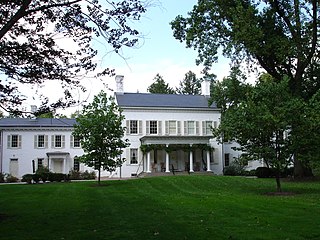
Morven, known officially as Morven Museum & Garden, is a historic 18th-century house at 55 Stockton Street in Princeton, Mercer County, New Jersey, United States. It served as the governor's mansion for nearly four decades in the twentieth century, and has been designated a National Historic Landmark for its association with Richard Stockton (1730-1781), a signer of the United States Declaration of Independence.

Pottersville is an unincorporated community split between Bedminster Township in Somerset County, Tewksbury Township in Hunterdon County and Washington Township in Morris County, New Jersey, United States. The area is served as United States Postal Service ZIP Code 07979. As of the 2010 United States Census, the population for ZIP Code Tabulation Area 07979 was 589. In 1990, most of the village was listed on the National Register of Historic Places as the Pottersville Village Historic District.

Mill Hill is a historic neighborhood located within the city of Trenton in Mercer County, New Jersey, United States. It is considered to be part of Downtown Trenton and was added to the National Register of Historic Places in 1977. The name Mill Hill refers to central New Jersey's first industrial site, a mill, erected in 1679, at the southeast corner of the present Broad Street crossing of the Assunpink Creek. Mill Hill and its wooden mill were among the holdings of the first settler in the vicinity of Trenton, Mahlon Stacy, a Quaker who arrived in North America in 1678. The mill was destroyed in a flood.
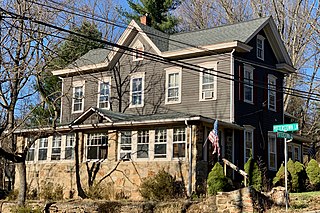
Potterstown is an unincorporated community along the border of Clinton and Readington townships in Hunterdon County, New Jersey.

Pennington Railroad Station is a disused train station in Pennington, Mercer County, New Jersey, United States. The station was built in 1882 by the Reading Railroad, and added to the National Register of Historic Places on December 31, 1974.

The Old Eagle Tavern is a historic building located at 431, 433 South Broad Street at the corner of Ferry Street in Trenton, Mercer County, New Jersey. The building was built in 1765 by Robert Waln. The building operated as a tavern and hotel from 1765 to 1896. It was added to the National Register of Historic Places on November 3, 1972 for its architectural, commercial, and political significance. The building is also a contributing property of the Trenton Ferry Historic District, which was listed on June 26, 2013.

Gen. Philemon Dickinson House is located in Trenton, Mercer County, New Jersey, United States.
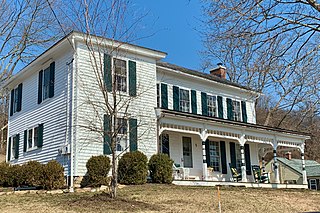
Amsterdam is an unincorporated community located within Holland Township in Hunterdon County, New Jersey. Located on the southern flank of the Musconetcong Mountain, the area was settled in the first half of the 18th century. It was later named after Amsterdam, Netherlands. The Amsterdam Historic District, encompassing the community, was listed on the state and national registers of historic places in 1995.

The Kingston Mill Historic District is made up of the Greenland–Brinson–Gulick farm, four nearby houses, the eponymous gristmill powered by the Millstone River, and the Kingston Bridge, an 18th-century stone arch bridge over the river. It was one of the first settlements in Princeton, New Jersey, preceded only by the Quaker community along the Stony Brook.

The King's Highway Historic District covers the portions of U.S. Route 206 and New Jersey Route 27 in New Jersey that connect Lawrenceville with Kingston through Princeton. This historic roadway dates to colonial times and was a portion of the King's Highway that was laid out by order of Charles II of England to connect Boston with Charleston. It is lined with many institutions and sites that have played an important role in the History of the United States, including Princeton University and the Princeton Theological Seminary.

The Rocky Hill Historic District encompasses the historic core of Rocky Hill, New Jersey along Washington Street and Montgomery, Princeton, and Crescent Avenues. The village is approximately one square mile and traces its beginnings to the 18th century, when George Washington stayed at Rockingham, and its major growth period to the second quarter of the 19th century. The district encompasses 145 buildings, only 12 of which are non-contributing, and has sustained its historic character without the intrusion of modern structures or parking lots. The most notable landmark in the village is Dutch Reformed Church, built in 1856 in the Carpenter Gothic style. The district was added to the National Register of Historic Places on July 8, 1982 for its significance in archeology, architecture and commerce.

The Trenton Ferry Historic District is a historic mixed-use urban working class neighborhood primarily composed of modest row houses, schools, churches, and commercial buildings. The neighborhood has roots in the 18th century but the majority of its fabric dates to the 19th and early 20th centuries. The district has few modern intrusions and has retained its historic character. The district was added to the National Register of Historic Places on June 26, 2013. It includes 581 contributing buildings and three contributing sites.

The Red Mill is a 4-story grist mill located along the South Branch Raritan River at 56 Main Street in Clinton, New Jersey. It was built c. 1810 as an industrial mill. It has served several roles, including a wool processing plant, a peach basket factory, and a textile mill. Historically known as the David McKinney Mill, it was added to the National Register of Historic Places on January 8, 1974 for its significance in agriculture and commerce. In 1995, it was also listed as a contributing property of the Clinton Historic District. It is now part of the Red Mill Museum Village, an open-air museum previously known as the Clinton Historical Museum.

The North Branch Historic District is a historic district located in North Branch, Somerset County, New Jersey. It is on the western side of the North Branch of the Raritan River in Branchburg Township. The district reflects the 18th and 19th century architecture of this agricultural community, once built around a mill on the North Branch. A main feature is the stone house of Jacob Ten Eyck, with its Georgian influences. The district was added to the National Register of Historic Places on April 16, 2012, for its significance in architecture and community development.

The Millstone Valley Agricultural District is a historic district located south of Millstone on the western side of the Millstone River along River Road / County Route 533 in Hillsborough Township, Somerset County, New Jersey. The district was added to the National Register of Historic Places on August 10, 1977.

Dunham's Mill, also known as Parry's Mill, is a historic building located at 7 Lower Center Street in Clinton, New Jersey, United States. The gristmill was in operation from 1837 to 1952. It was added to the National Register of Historic Places on April 15, 1982, for its significance in commerce and industry. In 1995, it was also listed as a contributing property of the Clinton Historic District. It shares the Clinton Dam across the South Branch Raritan River with the David McKinney Mill on the other side of the river. Since 1952, it has been home to the Hunterdon Art Museum, described by an art critic as the "most charming and picturesque" museum in the state.
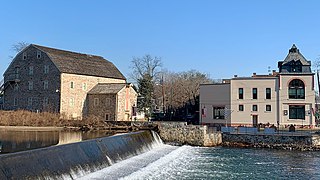
The Clinton Historic District is a 175-acre (71 ha) historic district encompassing much of the town of Clinton in Hunterdon County, New Jersey. It was added to the National Register of Historic Places on September 28, 1995, for its significance in architecture, commerce, engineering, industry and exploration/settlement. The district includes 270 contributing buildings, one contributing structure, and three contributing sites. Five were previously listed on the NRHP individually: Dunham's Mill, M. C. Mulligan & Sons Quarry, Music Hall, Old Grandin Library, and Red Mill.
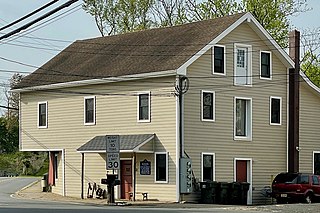
Salter's Mill is a historic gristmill built c. 1897 and located at 33 Imlaystown Road in the Imlaystown section of Upper Freehold Township in Monmouth County, New Jersey. It was added to the National Register of Historic Places on September 29, 1980, for its significance in agriculture, architecture, and exploration/settlement. The mill is next to a 28-acre (11 ha) mill pond, which was also used in the ice business. In 1985, it was also listed as a contributing property of the Imlaystown Historic District.
























